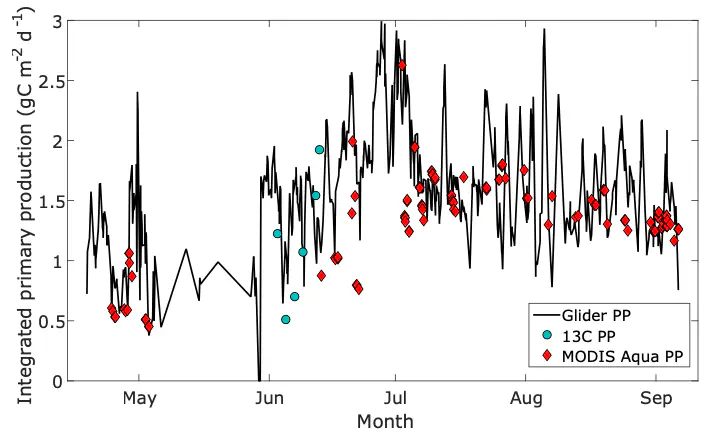Primary production and nitrate budgets in the temperate North Atlantic estimated from ocean gliders
 Primary production from Glider (black line), satellite (red dia- monds) and in situ 13C (blue circles)
Primary production from Glider (black line), satellite (red dia- monds) and in situ 13C (blue circles)
Abstract
Phytoplankton in the ocean are a key component of the global carbon cycle and the base of most marine food webs. They contribute approximately one half of total global primary production, but are restricted to the euphotic zone, where sunlight is sufficient for photosynthesis. Due to ocean stratification nutrients become limiting in the near-surface ocean and the distribution of phytoplankton is influenced by the upward flux of nutrients from below. In situ measurements of primary production and nutrient fluxes are generally sparse and questions still remain about quantifying how the physical mechanisms supplying nutrients balance the amount of growth. Using a year long observational dataset from ocean gliders and mooring data this thesis investigates primary production in the North East Atlantic and the associated vertical nitrate fluxes into the euphotic zone. A method was developed to estimate primary production from glider chlorophyll fluorescence and photosynthetic active radiation data using a primary production algorithm designed for satellite data. Primary production in the subsurface was quantified from the model, showing the formation of a subsurface primary production maximum, which contributed 23% of the total annual primary production. Concurrent nitrate fluxes are calculated from mooring vertical velocities and diffusivity measurements using a density-nitrate relationship derived from cruise CTD bottle samples. An estimate of the convective flux was also estimated using glider mixed layer depths. An annual timeseries of sub-daily estimates of primary production and nitrate fluxes was therefore obtained. Annual budgets show that nitrate fluxes could support between 75 and 102% of the observed primary production. The vertical advective flux contributes the largest vertical flux to the nitrate supply, and is therefore of greater significance than previously considered. Notable small scale temporal variability was observed in both the timeseries of primary production and nitrate fluxes, demonstrating an important influence from submesoscale and mesoscale processes on phytoplankton growth.